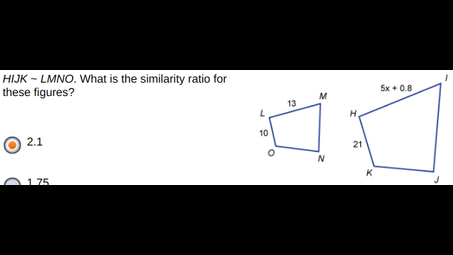What else can I help you with?
What do you call the ratio of corresponding side lengths are proportional?
You call it similarity.
What is the ratio of any two corresponding lengths in two similar geometric figures?
scale factor
What is next in the sequence ABDG?
Kadd one more letter each timeA + 1 = B = BB + 2 = CD = DD + 3 = EFG = GG + 4 = HIJK = K
If two figures are similar what is the scale factor?
The scale factor will depend on the side lengths. (Angle measures of the figures will be identical.) For example, if the smaller side had a length of 5 and the larger side had a length of 10 the ratio of the two figures would be 1:2.
What is true about corresponding angles and corresponding sides of similar figures?
The ratio between corresponding sides or angles of similar triangles are equal
what- Paper figures are cut out and used in a scrapbook. MNOP .What is the similarity ratio for the figures?
1.3
What is the similarity ratio of 4 to 16?
The similarity ratio is 1:4.
What is the ratio of Two triangles that are similar and have a ratio of similarity of 310 what is the ratio of their areas?
If the ratio of similarity is 310, then the ratio of their area is 96100.
HIJK is definitely a parallelogram?
A. True
How do you find the similarity ratios of two similar prisms?
Measure any two corresponding edges. The ratio of these edges is the similarity ratio.
How can you find perimeter of two similar figures?
You need to find the perimeter of one by adding together the lengths of all its sides. The perimeter of the similar shape is the answer multiplied by the similarity ratio.
What is a similarity ratio?
similarity ratios are ratios in which both the ratios are equal to each other
What is the similarity ratio of 48 and 75?
The similarity ratio of two numbers is found by dividing one number by the other. For 48 and 75, the ratio can be expressed as 48:75. To simplify, you can divide both numbers by their greatest common divisor, which is 3, resulting in a simplified ratio of 16:25. Thus, the similarity ratio of 48 and 75 is 16:25.
What is the similarity ratio for two circles with areas 2π m2 and 200π m2?
The similarity ratio of two circles can be determined by the ratio of their areas. Given the areas of the circles are 2π m² and 200π m², the ratio of the areas is ( \frac{2\pi}{200\pi} = \frac{2}{200} = \frac{1}{100} ). The similarity ratio, which is the square root of the area ratio, is therefore ( \sqrt{\frac{1}{100}} = \frac{1}{10} ). Thus, the similarity ratio of the two circles is ( 1:10 ).
If two figures are congruent then they are similar?
Yes. Congruence implies similarity. Though similarity is not enough for congruence.
What is the similarity ratio for 60 to 150?
2 to 5
What is the ratio similarity of 432 and 48?
9:1

